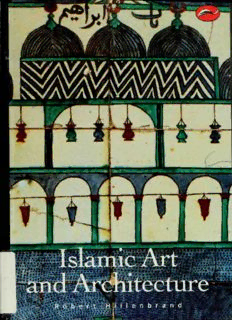
Islamic Art and Architecture PDF
Preview Islamic Art and Architecture
MMMMMHI ?•.:'... « ;i I I e n b r a n d Boston Public Library Robert 1lillenbrand was educated at the universities of Cambridge and Oxford. Since [97] he has taught .it the University of Edinburgh, and in [989 was made Professoi of Islamic Art there. He has travelled extensively throughout tl Islamic world from Morocco to Southeast \sia, and has held visiting professorships at Princeton, 1 os Angeles. 1Dartmouth and Bamberg. He is the author ofover a hundred publications, includingbooks on Persian painting and Islamic architecture. <£* WORLD OF ART This famous series provides the widest available range ofillustrated books on art in all its aspe<ts Ifyou would like to receive a complete list oftitles m print please write to: 1HAM]s wo ill Dso\ 30Bloomsbury Street. I ondon w< IB 3QP IntheUnitedStatesplease write to: - f m . THAMES AJMJ^fll^ *' Avenue.:. NNeeww Y>ork, Ne* York 101 1.6 , No le- the I gale of ! 1 ft Robert Hillenbrand Islamic Art and Architecture 2jo illustrations, So in color THAMES AND HUDSON ForMargaret and Ruthie, with love and thanksfor years ofencouragement frontispieceRustamlassoingKamus. Firdausi. Shaknama, probably Tabriz,c. 1505; attributabletoSultanMuhammad. Rustam. thehero oftheShahnama,thePersiannationalepic, isdistinguishedbvthetiger skinthathewearsoverhisbodyarmourandhisleapaid's-headcasque crownedbyamightyseven-foldplume. Notethefloatingtextpanels andconcealedgrotesquesinthelandscape. ACKNOWLEDGMENTIoweagreatdealto DrBarbara Brend. whoread thetextwithpainstakingcareandunstinnnglvprovidedmain suggestionsforitsimprovement. Thebookismuchthericherf|orher efforts. Anycopyofthisbookissuedbythepublisherasjpaperb.uk issold w subjecttotheconditionthatitshall notby wayoftradeorother isebe lent,resold,hiredoutorotherwisecirculatedwithoutthepublisher's priorconsentinanyformofbindingorcoverotherthanthat in which it ispublishedandwithoutasimilarcondition includingthesewordsbeing imposedonasubsequentpurchaser. © 1999ThamesandHudson Ltd. London Firstpublishedin paperbackinthe United StatesofAmerica U byThamesandHudson Inc.. SOO Firth Avenue. New York. New York Io11 EB BR LibraryofCongressCatalogCard Number N^AA338800 isbn0-500-20305-9 .HH5522 1. 999x AllRightsReserved Nopanofthispublication may be reproducedor transmittedinanyformorbyanymeans, electronic ormechanical, includingphotocopy, recordingoranyotherinformationstorageand retrievalsystem,withoutpriorpermissioninwritingfromthepublisher PrintedandboundinSlovenia Contents Introduction CHAPTER ONE The Birth ofIslamic Art: the Umayyads 10 CHAPTER TWO The eAbbasids CHAPTER THREE The Fatimids 6l CHAPTER FOUR The Saljuqs B6 CHAPTER FIVE The Age ofthe Atabegs: Syria, Iraq and Anatolia, 100-1300 i 1 1 1 CHAPTER SIX The Mamluks [38 CHAPTER SEVEN The Muslim West [67 CHAPTER EIGHT The Ilkhanids and Timurids [96 CHAPTER NINE The Safavids 226 CHAPTER TEN The Ottomans 2$5 SELECT BIBLIOGRAPin -s ' OSSARY ( I sol R( is 01 Mil STRATIONS INI) X I THEISLAMIC WORLD FROM ANATOLIA TO CENTRAL ASIA KHURASAN Bukhara * Samarqajul Men RANSOXIANA vr>l'<y, Tinnidh Sarakhs »Ti Sultaniy; ^amgnaj .^^NMi.sh, apur-. •M,asSahnhgabdast C; A R J I S T A N Qazvm Tehran •Simnan •Zuzan Kabu] R~7aJw Khargird #X araniin Herat Qumm» Ghazna Kashan* •Natanz •Tab. Zavara• •Ardistan Isfaha Introduction Any attempt to make sense ofIslamic art and architecture as a whole while retaining a chronological framework runs the risk of distor- tion. Bias ofseveral different kinds is hard to avoid. It is simply not possible to be equally well informed and equally interested in all aspects ofthe subject. The need to consider in some detail the early centuries of Islamic art is made imperative by the major impact which work ofthis period had on later art. But a great deal of this early art has perished, and to do justice to what survives in the context ofits own time and ofsubsequent periods demands a closer and more detailed focus than is appropriate for the more numerous examples of later art. Some degree of over-balance is therefore inevitable. Certain art forms such as calligraphy or textiles continued to be produced in most parts ot the Islamic world from early times, but they are not of equal significance in each area or period. Thus the absence ofa discussion of, say, Tulunid woodwork, Maghribi pottery, Timurid textiles, Spanish metahvork or Ottoman Qur'ans should not be interpreted as a signal that they did not exist, have not sur- vived or are ofperipheral interest. It is simply that it seemed best to reserve a discussion ofcertain media for those periods m which pro- duction was ofthe most significant scale and quality Similarly, the art of entire dynasties - Ghaznavid, Turcoman, the beyliks of Anatolia, the muluk al-tawa'ifof medieval Spain - is virtually ignored. Such omissions are dictated by the rigorous word limit and the need to see the wood rather than the trees. In other words, the option oftrying to say something, however little, about almost everything, and thus writing a rather bland and trivial text, was rejected. It seemed prefer- able to single out key objects and monuments for relatively detailed scrutiny, in the hope that they would provide a means ofentry into the school or style that produced them. This book, then, is more a study ofthe peaks than ofthe valleys; its colours are intended to be bold and primary.
